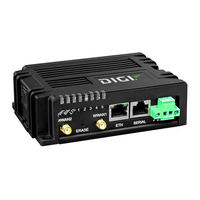Digi IX10-00N4 Manuals
Manuals and User Guides for Digi IX10-00N4. We have 1 Digi IX10-00N4 manual available for free PDF download: User Manual
Digi IX10-00N4 User Manual (874 pages)
Brand: Digi
|
Category: Network Router
|
Size: 13 MB
Table of Contents
-
IX10 Leds27
-
Power (PWR)28
-
Sim28
-
Lte28
-
SIM Removal35
-
Local Webui40
-
Learn more68
-
Interfaces69
-
Delete a WWAN121
-
Configure a LAN125
-
Delete a LAN137
-
DHCP Servers139
-
Serial Port162
-
Routing204
-
IP Routing205
-
Routing Services219
-
Dynamic DNS223
-
Vrrp229
-
Configure VRRP229
-
Configure VRRP233
-
Ipsec255
-
Ipsec Mode255
-
Ipsec Modes255
-
Authentication256
-
Openvpn311
-
Show GRE Tunnels350
-
L2Tp366
-
L2TP with Ipsec383
-
L2Tpv3 Ethernet385
-
Nemo391
-
Show NEMO Status397
-
Configure DNS430
-
Show DNS Server436
-
SNMP Security438
-
Download Mibs443
-
Modbus Gateway476
-
System Time494
-
Python Modules529
-
Local Users600
-
Ldap626
-
Packet Filtering665
-
Downgrading703
-
Intelliflow741
-
File System754
-
View System Logs766
-
View Event Logs768
-
Safety Warnings804
-
English805
-
French--Français808
-
Polish--Polskie814
-
Slovak--Slovák816
-
Spanish--Español818
-
The Help Command824
-
Show Config829
-
Show System830
-
Show Network830
-
Analyzer Clear846
-
Analyzer Save847
-
Analyzer Start847
-
Analyzer Stop847
-
Container Create848
-
Container Delete848
-
Help848
-
Mkdir851
-
Modem at851
-
Modem Pin Change853
-
Modem Pin Enable853
-
Modem Pin Status854
-
Modem Pin Unlock854
-
Modem Puk Status854
-
Modem Puk Unlock854
-
Modem Reset855
-
Modem Scan855
-
Modem Sim-Slot855
-
Monitoring855
-
More856
-
Ping856
-
Reboot858
-
Scp860
-
Show Analyzer860
-
Show Arp860
-
Show Cloud860
-
Show Config861
-
Show Containers861
-
Show Dhcp-Lease861
-
Show Dns861
-
Show Event861
-
Show Hotspot862
-
Show Ipsec862
-
Show L2Tp Lac862
-
Show L2Tp Lns862
-
Show L2Tpeth863
-
Show Location863
-
Show Log863
-
Show Manufacture863
-
Show Modem864
-
Show Nemo864
-
Show Network864
-
Show Ntp864
-
Show Route865
-
Show Scep-Client865
-
Show Scripts866
-
Show Serial866
-
Show System867
-
Show Usb867
-
Show Version867
-
Show Vrrp867
-
Show Web-Filter868
-
Speedtest868
-
Ssh868
-
System Backup868
-
System Find-Me870
-
System Restore871
-
System Time Set873
-
System Time Sync873
-
System Time Test873
-
Telnet873
-
Traceroute874
Advertisement
Advertisement
